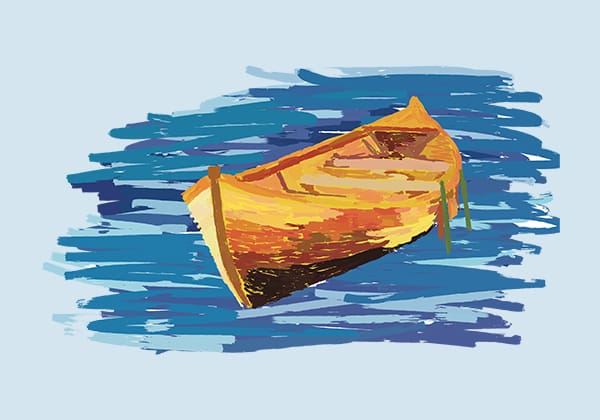“The new world — El Dorado, Atlantis, the Gold Coast, Newfoundland, Plymouth Rock, Rapanaui, Utopia, Planet Blue. Chanc’d upon, spied through a glass darkly, drunken stories strapped to a barrel of rum, shipwreck, a Bible Compass, a giant fish led us there, a storm whirled us to this isle.”
Jeanette Winterson, The Stone Gods
In The Stone Gods by Jeanette Winterson, a spaceship sets out across the firmament from a dying planet, carrying what’s needed to establish a new planet that can sustain human life. It is plastered with old ship diaries and poetry from centuries past, from Cook to Donne. They offer shreds of hope to its futuristic, star-age voyagers, for whom sailboats are mythic artefacts of faraway time…
Sea-faring, once the pinnacle of peril and adventure, folklore and piracy, has been lost to the rise of aircraft.
These fantasies can be traced back to The Golden Age of Sail of the mid-16th and 19th centuries, which rapidly increased the importance of our waters to technology, politics, and public life. Sailors traded stories as they did silk, spices, and rum, and port cities became the cosmopolitan centres of the world. This collective ‘turn’ of Western society from land to sea was buttressed by centuries of imperialism and orientalism. Visually and economically, ships projected European imperial sovereignty onto seas around the world, which resulted in the accumulation of Western capital from the late 15th century onward.
Today, aeroplanes are loud, fast and unromantic. We glean the sky through tiny, double-ply acrylic windows, move our feet to the command of flight timetable boards, and shoot through space like flecks of dust. There is little time in the work life cycle to spend months at sea— to be adrift might as well be to sink.
But while land has long represented stability, sovereignty, and nationalism, the sea is a pulse of mythology and history.
According to Foucault, sea-travel was not only the “greatest instrument of economic development” in the West from the sixteenth century onwards, but “simultaneously the greatest reserve of the imagination.”
“In civilisations without ships, dreams dry up, espionage takes the place of adventure, and police take the place of pirates,” he wrote.
The nautical narrative is renewed time and time again. Most recently, the sea-shanty and pirate craze took over TikTok, just as the Pirates of the Caribbean franchise captivated audiences in the early 2000s.
Historian Margaret Cohen calls the major cultural shift to a ‘sublime’ ocean in the mid-eighteenth century the ‘Romantic gentrification of the seas’. Prior to this, the waters connecting the globe were purely a means for transportation, as well as a fearsome, biblical reminder of human mortality.
In the West, the ‘wine-dark sea’ of The Odyssey, the voyage of the Argonauts in Medea, the wrathful god Poseidon, and the ‘Great Flood’ of Noah’s Ark, embody this premodern view of our ocean, and sea voyage.
On the other hand, Defoe’s Robinson Crusoe (1716), Coleridge’s The Rime of the Ancient Mariner (1798), and Melville’s Moby Dick (1816) comprise the literary topography of the Golden Age of Sail, and the Romantic nautical movement.
It was around this time that the image of pirates as raffish, loveable rogues was conceived, with Daniel Defoe’s pseudonymic biography A General History of the Robberies and Murders of the Most Notorious Pyrates (1724), and later with Captain Long John Silver in Stevenson’s Treasure Island (1882).
However, Cohen says this Romantic shift also led to “a socially constructed ocean.” Ships emerged as some of the first engines of capitalism, commodifying human labour through so-called ‘maritime proletariats’ in the damp, disease-ridden circumstances. Masculinity, virility, and colonialism characterised the ‘yarns’ which scaffolded the collective imaginations of sailors and later novelists; enchanting, socialising, and educating new recruits, and easing the monotony of ship-hand labour.
***
The sea narrative is not submerged, but its details are washed up, set adrift. It’s meaning is tidal, constantly transforming. The question remains of what enduring magic it holds for a modern society of mass aviation, that has scrutinised, domesticated, and despoiled almost every corner of earthly life.
In the refrain from Winterson’s novel, the voyage holds a transgressive power to deliver a sense of forgiveness and rebirth to its undertakers. In dreaming, human beings inhabit not the land desecrated by their own hands, but the realms of sea and stars that flank it— where the world is still newly made, and we are light and clean.
When we think of the sea, it’s with the innocent tint of holidays past. It’s in the refrain of a story reworked from a sailor’s yarn by children, playing on the shore of a beach like a touchable golden dream.
It is the ‘scallop full of moonlight’ described by Mary Oliver, the pearl-eyes of a drowned king in The Tempest, Whitman’s pleas falling on the deaf ears of a dead captain.
Our water is human history, the shores from which we crawled. It is time immemorial— a locked, cool, blue secret.





